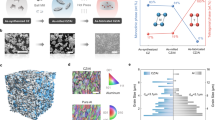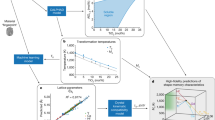Abstract
High-strain-rate superplasticity describes the ability of a material to sustain large plastic deformation in tension at high strain rates of the order of 10-2 to 10-1 s-1 and is of great technological interest for the shape-forming of engineering materials. High-strain-rate superplasticity has been observed in aluminium-based1 and magnesium-based2 alloys. But for ceramic materials, superplastic deformation has been restricted to low strain rates of the order of 10-5 to 10-4 s-1 for most oxides3,4 and nitrides5 with the presence of intergranular cavities leading to premature failure. Here we show that a composite ceramic material consisting of tetragonal zirconium oxide, magnesium aluminate spinel and α-alumina phases exhibits superplasticity at strain rates up to 1 s-1. The composite also exhibits a large tensile elongation, exceeding 1,050 per cent for a strain rate of 0.4 s-1. The tensile flow behaviour and deformed microstructure of the material indicate that superplasticity is due to a combination of limited grain growth in the constitutive phases and the intervention of dislocation-induced plasticity in the zirconium oxide phase. We suggest that the present results hold promise for the application of shape-forming technologies to ceramic materials.
This is a preview of subscription content, access via your institution
Access options
Subscribe to this journal
Receive 51 print issues and online access
$199.00 per year
only $3.90 per issue
Buy this article
- Purchase on Springer Link
- Instant access to full article PDF
Prices may be subject to local taxes which are calculated during checkout




Similar content being viewed by others
References
Nieh, T. G., Gilman, P. S. & Wadsworth, J. Extended ductility at high strain rates in a mechanically alloyed aluminum alloy. Scripta Metall. 19, 1375–1378 (1985).
Mabuchi, M. & Higashi, K. High-strain-rate superplasticity in magnesium matrix composites containing Mg2Si particles. Phil. Mag. A 74, 887–905 (1996).
Wakai, F., Sakaguchi, S. & Matsuno, Y. Superplasticity of yttria-stabilized tetragonal ZrO2 polycrystals. Adv. Ceram. Mater. 1, 259–263 (1986).
Kajihara, K., Yoshizawa, Y. & Sakuma, T. The enhancement of superplastic flow in tetragonal zirconia polycrystals with SiO2-doping. Acta Metall. Mater. 43, 1235–1242 (1995).
Wakai, F. et al. A superplastic covalent crystal composite. Nature 344, 421–423 (1990).
Kim, B.-N., Hiraga, K., Sakka, Y. & Ahn, B.-W. A grain boundary diffusion model of dynamic grain growth during superplastic deformation. Acta Mater. 47, 3433–3439 (1999).
Smith, C. S. Grains, phases and interfaces: an interpretation of microstructure. Trans. Metall. Soc. AIME 175, 15–51 (1948).
Kim, B.-N., Hiraga, K., Morita, K. & Sakka, Y. Superplasticity in alumina enhanced by co-dispersion of 10% zirconia and 10% spinel particles. Acta Mater. 49, 887–895 (2001).
McQueen, H. J. & Jonas, J. J. in Treatise on Materials Science and Technology Vol. 6 (ed. Arsenault, R. J.) 393–493 (Academic, New York, 1975).
Ting, C.-J. & Lu, H.-Y. Hot-pressing of magnesium aluminate spinel—II. microstructure development. Acta Mater. 47, 831–840 (1999).
Morita, K. & Hiraga, K. Deformed substructures in fine-grained tetragonal zirconia. Phil. Mag. Lett. 81, 311–319 (2001).
Schissler, D. J., Chokshi, A. H., Nieh, T. G. & Wadworth, J. Microstructural aspects of superplastic tensile deformation and cavitation failure in a fine-grained yttria stabilized tetragnal zirconia. Acta Metall. Mater. 39, 3227–3236 (1991).
Pilling, J. & Ridley, N. Effect of hydrostatic pressure on cavitation in superplastic aluminium alloys. Acta Mater. 34, 669–679 (1986).
Evans, A. G., Rice, J. R. & Hirth, J. P. Suppression of cavity formation in ceramics: prospects for superplasticity. J. Am. Ceram. Soc. 63, 368–375 (1980).
Wittenauer, J. Applications of ceramic superplasticity: challenges and opportunities. Mater. Sci. Forum 243–245, 653–662 (1997).
Acknowledgements
We thank N. Sekine for experimental assistance.
Author information
Authors and Affiliations
Corresponding author
Rights and permissions
About this article
Cite this article
Kim, BN., Hiraga, K., Morita, K. et al. A high-strain-rate superplastic ceramic. Nature 413, 288–291 (2001). https://doi.org/10.1038/35095025
Received:
Accepted:
Issue Date:
DOI: https://doi.org/10.1038/35095025
This article is cited by
-
A facile synthesis and characterization of spinel Zinc-Chromite (ZnCr2O4) nanoparticles: their photocatalytic, antibacterial, and anticancer activities
Journal of Sol-Gel Science and Technology (2024)
-
Contribution of boundary non-stoichiometry to the lower-temperature plasticity in high-pressure sintered boron carbide
Nature Communications (2023)
-
Detailed study of structural, optical, dielectric and electrical properties of Ni0.7Cd0.3Cr2O4 (NCCO) chromite prepared using sol-gel method
Journal of Sol-Gel Science and Technology (2023)
-
Comprehensive Investigation of Structural, Morphologic, Optical, Dielectric and Electrical of Ni0.3Cd0.7Cr2O4 Chromite to Optoelectronic Application
Journal of Inorganic and Organometallic Polymers and Materials (2023)
-
Differential superplasticity in a multi-phase multi-principal element alloy by initial annealing
Journal of Materials Science (2022)
Comments
By submitting a comment you agree to abide by our Terms and Community Guidelines. If you find something abusive or that does not comply with our terms or guidelines please flag it as inappropriate.



